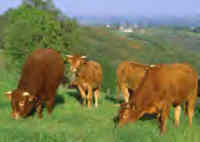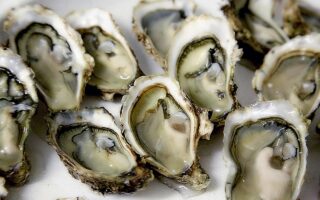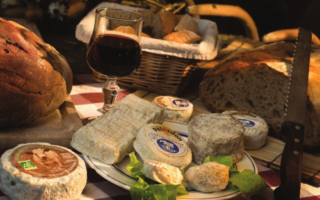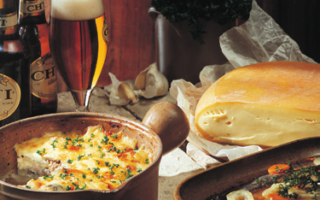
The Good Veal Guide
|
The Aveyron is the No.1 producer of meat in the South of
France and is particularly renowned for the quality of it’s meat, the
Label Rouge guarantees the superior quality. In the Aveyron, and
especially in Segala, the veal farmers adhere to this label and look
after their calves as well as on any other animal farm.
 The “Veau de l’Aveyron” calves graze free range in the large rolling The “Veau de l’Aveyron” calves graze free range in the large rolling
criss-cross of fields and woods from Cordes to the outskirts of Rodez,
including the Aveyron Valley and its Gorges, between Belcastel and Najac
and Segala. Because the animals are raised without stress, the meat is
pink, tender and delicately flavoured. Like many people you may have
been misguided by outdated information about veal and its production.
There maybe some veal farms where old methods still existin France but
not on the farms which have the Label of Veal of Aveyron and Ségala
attributed.
The IRVA (Interprofession
Regionale du Veau d‘Aveyron et du Ségala ) describes how the veal is
produced.
THE VEAL CALVES OF AVEYRON AND SÉGALA
The veal calves of Aveyron and Ségala belong traditionally to the
regions of the plateau of Ségala in the Tarn and the districts (cantons)
of the bordering departments (Aveyron, Lot, Tarn, Tarn-et-Garonne).
Here the farmers have developed a breeding tradition unique in Europe
thanks to a know-how of several generations which has been enriched with
current methods of selecting and looking after the herds.
PROTECTED GEOGRAPHICAL INDICATION OR « INDICATION GÉOGRAPHIQUE
PROTÉGÉE » (I.G.P.)
Due to European Law which came into force in 1992, the IGP protects the
name of product which comes from a specific geographic area.
This guarantees the reputation, the quality or a specificity of a
product for which the production and/or transformation and/or
manufacturing must take place in this geographical area.
THE TYPE OF CATTLE
The veal calves of Aveyron and Ségala must be from the following breeds:
Limousin:
This breed originating from the Limousin department.
They are recognisable by their distinctive golden-red colouring.
The Blonde d’Aquitaine:
This breed originates from the Aquitaine
district in south west of France embracing the area of the Garonne
valley and the Pyrenees. Blondes show some variation of colour ranging
from almost white to a light tan.
The breed criterion is very important for the quality of the meat.
THE PRODUCTION IS BUILT ON THE STRONG TRADITION OF SÉGALA
The farm buildings must offer an optimal comfort for the animals:
a clean environment is necessary for the healthy development of the
animals
there must be sufficient natural lighting and good ventilation
the straw on which they lie must be kept clean and be regularly
changed
there must be sufficient room so that the animals can move freely.
they are not never kept in cramped condition and certainly not in any form of
crates.
the buildings must be disinfected periodically
The loading of the calves on the farm, the transport and the unloading
at the slaughter house must take place calmly and without any stress in
order to avoid any discomfort to the animals.
THE DIET
The diet of the veal calves of Aveyron and Ségala is of paramount
importance for the quality of the meat and is based on milk and cereals.
This system avoids the calves becoming anaemic.
The calves always have water and hay at their disposal. The use of
ensilage (process of preserving green food for cattle in an undried
condition in a storage silo) is forbidden and synthetic hormone or
growth treatment is strictly forbidden.
During their life, the veal calves will drink 2500 litres of milk and
consume 500 kg of cereals. The calves are always raised in a suitable
environment until they are between 6 to 10 months and they weigh about
220kg. In comparison pigs are about the same age when they are ready for
consumption whereas chickens are only 6 weeks.
GUARANTEE OF QUALITY AND ORIGIN
From birth, the Veal of Aveyron and Ségala are controlled in a specific
way as detailed above.
Bred in a long tradition and, in the respect of specifications
officially agreed, the Veal of Aveyron and Ségala are rigourously
selected in order to offer meat of premium quality.
This food chain is controlled by an independent certifying organization
Qualisud, approved for the standard EN45011.
The Veal of Aveyron and Ségala have been awarded 3 official symbols of
quality: |
 |
 |
 |
I.G.P.
Protected Geographical Indication Approval N°38.94
EU
Official Journal of 21 06 96
|
Label Rouge
Approval N°LA 08.93
Official Journal of 12 02 1994
on meat |
Label Rouge
Approval N°LA 34.99
Official Journal of 20 06 2001
on processed Products |
THE UK GOOD VEAL CAMPAIGN
Veal has been excluded from British menus for nearly 20 years. Now it’s
back – or at least it will be, if a newly-formed veal alliance has its
way. A campaign has been launched by farmers and chefs to put the case
for veal to the public on what might seem perverse to die-hard opponents
– animal welfare grounds.
The Good Veal Campaign is promoting not the old veal produced in the UK
before the crate system was banned in 1990 but the new veal – where
calves are reputed to live as happy a life as any pig. The campaign was
launched in September 2006 by River Cottage TV presenter Hugh Fearnley-Whittingstall and the cook Sophie Grigson at the Organic Food
Awards in Bristol.
The veal lobby has also been given another lift – by Janet Street
Porter, The Independent on Sunday’s editor-at-large, who gave veal the
seal of approval after investigating it for
Channel 4’s F Word. In the
nine days since the programme, veal sales have risen 45 per cent at
Waitrose in the first week alone.
HOW TO COOK VEAL
Just cook it with salt and pepper. Once cooked it must be pink in the
middle. But each cut must be cooked in a different manner as shown in
the table below:
In order to prepare |
Cut to Choose |
Number of gram per person |
How to Cook |
Escalope
|
Cushion |
150 g |
1 min per cm of thickness to sear by turning frequently |
|
Medallion |
Filet |
150 g |
2 mins per side for a medallion of 2 cm |
|
Chop |
Loin chop, chop |
200 g |
1 to 2 min per side |
|
Roast |
Cushion, shoulder, quasi (upper part of leg of veal) |
150 g |
For 1 kg in the oven or in the pressure cooker, allow 40 mins of
cooking time (start on a high heat for 10 mins and then continue
on a low heat) |
|
Meat cooked in a sauce |
Shoulder, tendon, flank, neck, knuckle, breast |
150 g to 250 g |
1 hr 30 min on a low heat |
|
Boiled meat |
Shoulder, tendon, flank, neck, breast 180 g to 250 g 1h 30 min
minimum |
180 g to 250 g |
1h 30 min minimum |
With this delicious meat, you can cook many dishes including Sauté of
Veal with Armagnac or Blanquette of Veal which is France’s favourite
dish. In a recent opinion poll 24% of the French chose it as their
preferred meal. (Source:
Sofres – French leading opinion
poll organization)
<p
|
|
© FrenchEntrée Tarn & Aveyron
Share to:
Facebook
Twitter
LinkedIn
Email
More in
aveyron, food, guides, people, river, tarn
Your email address will not be published. Required fields are marked *


 The “Veau de l’Aveyron” calves graze free range in the large rolling
The “Veau de l’Aveyron” calves graze free range in the large rolling



